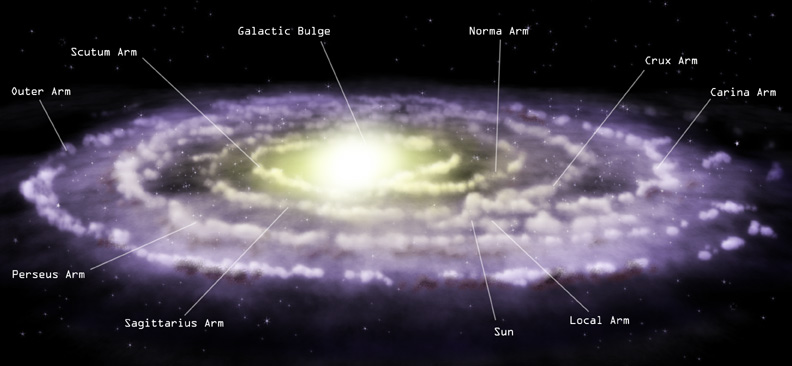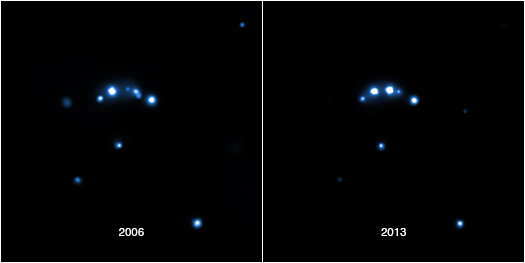Getting a Sense of Place in our Universe
The biggest science news this week, by far, has been a new study suggesting that Earth-sized planets in habitable zones may be very common. This is exciting news – who wouldn't want to have more cosmic planetary friends out there that maybe one day we'll be able to explore? By the latest accounts, there could be billions of Earth-like planets out there in our Milky Way galaxy.

FITS and Starts
In continued recogintion of American Archives month, we've dusted off some raw data from recent Chandra press releases over the past year for inclusion in our openFITS collection. This brings the total collection up to 20 objects including supernova remnants, active galaxies, star forming regions, black holes, and pulsars and neutron stars. These data are ripe for exploration. The new data sets include the Vela Pulsar Jet, and supernova remnants W49B and G1.9+0.3 (which also happens to be the Milky Way's most recent supernova remnant).

Preserving the Legacy of the X-ray Universe
Every year, October is designated as American Archive Month. While many people may think "archive" means only dusty books and letters, there are, in fact, many other types of important archives. This includes the use of archives for major telescopes and observatories like NASA's Chandra X-ray Observatory.
A Glimpse of the Violent Past of Milky Way's Giant Black Hole
Researchers using NASA's Chandra X-ray Observatory have found evidence that the normally dim region very close to the supermassive black hole at the center of the Milky Way Galaxy flared up with at least two luminous outbursts in the past few hundred years.
This discovery comes from a new study of rapid variations in the X-ray emission from gas clouds surrounding the supermassive black hole, a.k.a. Sagittarius A*, or Sgr A* for short. The scientists show that the most probable interpretation of these variations is that they are caused by light echoes.
Celebrating Ada Lovelace Day
Today is Ada Lovelace Day. Who is Ada Lovelace, you might ask? She lived in the mid-19th century and is considered by many to be the first computer programmer. The goal of Ada Lovelace Day is help celebrate and promote the achievements of women in the subjects of science, technology, engineering, and mathematics (aka, STEM).
Of course, we at Chandra always jump at the opportunity to highlight the role that women play not only in the scientific endeavors of the mission, but also the computer, engineering, and other critical functions of the observatory. You can meet some of these fascinating women through our blog series, Women in the High-Energy Universe (also in a printable pdf handout).
The organizers of the Ada Lovelace Day hope that this event will spur discussion and further awareness about the irreplaceable achievements women are responsible for in STEM fields. Hopefully, more people from all backgrounds are drawn toward STEM topics both during their education and once on their career paths. And we look forward to helping explore the Universe with anyone who wishes to join the journey.
Discover and Explore with the Chandra Skymap
American Archives Month (each October) is an exciting time around here. We spend a lot of time working through the Chandra archive to bring you the best and most interesting objects in the X-ray Universe that have made their way across space and time (via photons) to Chandra's detectors.
It has been a personal goal of mine, since taking this job as Chandra science imager about four years ago, to create an interactive tool for the public to engage with the Chandra archive of released imagery in a new and innovative way. For this to work, a few pieces of the puzzle had to fall into place.
Mirror Man
Less than 50 years after the first detection of an extrasolar X-ray source, the Chandra X-ray Observatory has achieved an increase in sensitivity comparable to going from naked-eye observations to the most powerful optical telescopes over the past 400 years. Many individuals have been involved in this phenomenal accomplishment, but in this contribution, we focus on one: Leon Van Speybroeck.
Leon Van Speybroeck (Credit: NASA/MSFC/K. Stephens)
Leon was one of a number of newly minted MIT physics Ph.D.'s (including Paul Gorenstein, Martin Zombeck, Ethan Schreier, and one of us (HT)) who in the mid-late1960's made the short move from the MIT campus to the revamped milk-truck garage a few blocks away that was the site of American Science & Engineering. It was there that Riccardo Giacconi had assembled an X-ray astronomy group that had discovered the first cosmic X-ray source during a short rocket flight.
Neutron Star Undergoes Wild Behavior Changes
These two images from NASA's Chandra X-ray Observatory show a large change in X-ray brightness of a rapidly rotating neutron star, or pulsar, between 2006 and 2013. The neutron star - the extremely dense remnant left behind by a supernova - is in a tight orbit around a low mass star. This binary star system, IGR J18245-2452 (mouse over the image for its location) is a member of the globular cluster M28.
NASA's Hubble and Chandra Find Evidence for Densest Nearby Galaxy
The densest galaxy in the nearby Universe may have been found, as described in our latest press release. The galaxy, known as M60-UCD1, is located near a massive elliptical galaxy NGC 4649, also called M60, about 54 million light years from Earth.
A Giant Among Dwarfs

We are very pleased to welcome Jay Strader as a guest blogger today. Jay is the first author of a paper describing evidence for the densest known galaxy in the nearby universe, the subject of our latest press release. He is an assistant professor in the Department of Physics and Astronomy at Michigan State University. From 2007-2012 he was a Hubble Fellow and Menzel Fellow at the Harvard-Smithsonian Center for Astrophysics. He earned his BS in Physics and Mathematics at Duke University, and his PhD at the University of California-Santa Cruz. As his Twitter biography says (@caprastro), he loves "goats, birds, the Celtics, and globular clusters".
Explaining the basic properties of galaxies from spirals like our own Milky Way to dwarf galaxies like the Magellanic Clouds has been one of the central occupations of astronomers over the last few decades. Most astronomers now favor a picture in which galaxies form at the center of condensed "halos" of mysterious dark matter. Gas flows into these halos, cools, and forms stars and planets. The most massive galaxies are built up by mergers of smaller galaxies, which can shut off new star formation and leave behind "dead" elliptical galaxies. This basic scenario is a framework through which we can understand the formation of the known types of galaxies.






